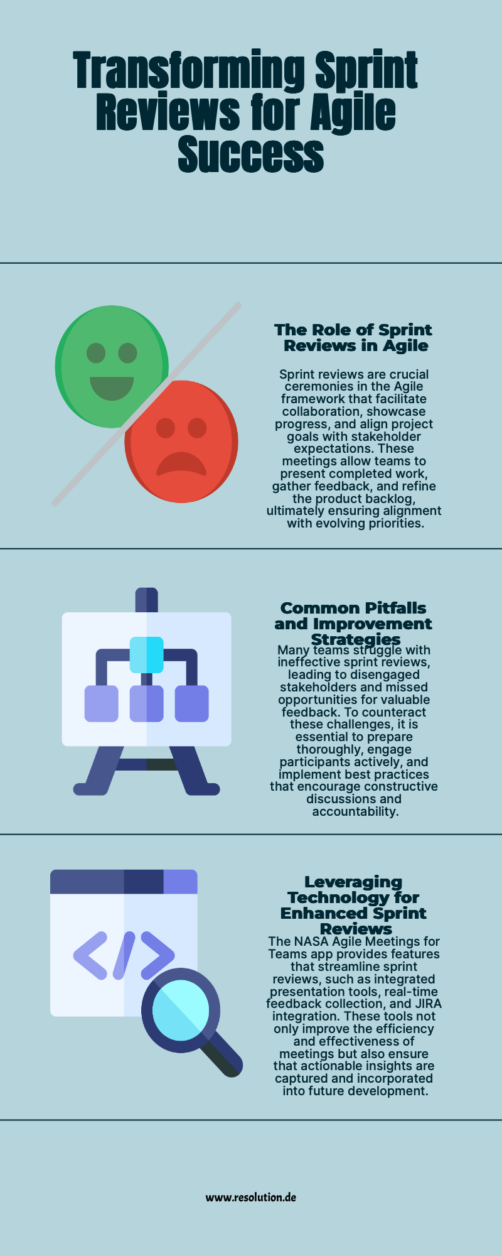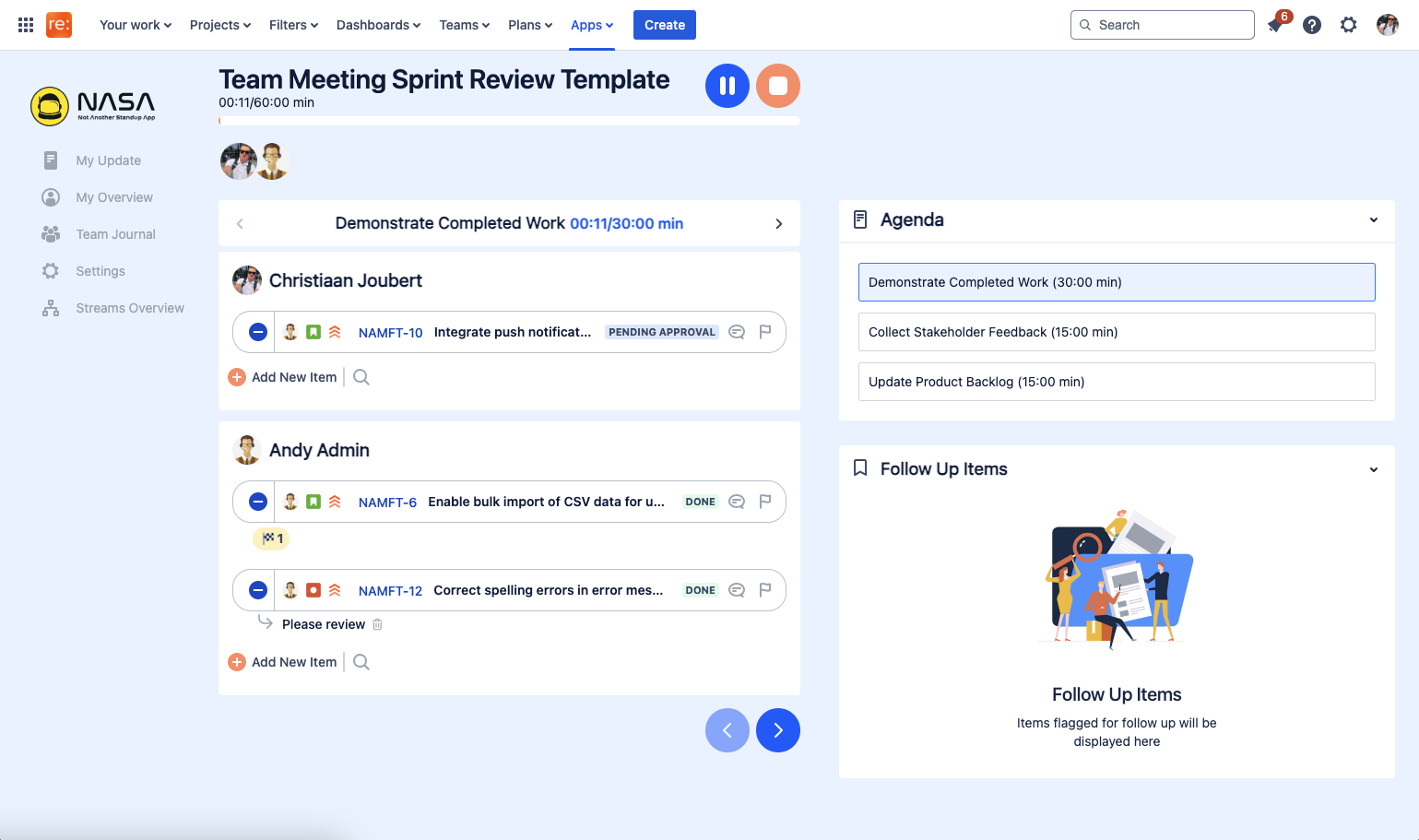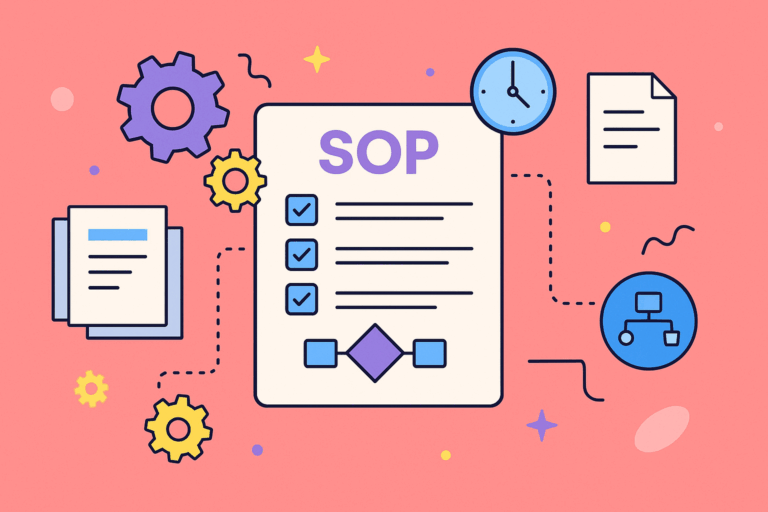In the Agile framework, sprint reviews serve as a key ceremony to foster collaboration, showcase progress, and ensure alignment with stakeholders. These reviews occur at the end of each sprint, providing a platform for agile teams to present completed work, collect actionable feedback, and refine the product backlog to align with evolving priorities.
Yet, many teams face challenges in making sprint review meetings truly impactful. From stakeholder disengagement to feedback mismanagement, poorly executed reviews can hinder progress and undermine team morale. By understanding best practices and leveraging modern tools, agile teams can transform scrum sprint reviews into productive, engaging sessions that drive value.
This article delves into the essentials of sprint reviews, offering actionable insights for improving these ceremonies. We’ll also highlight how the NASA Agile Meetings for Teams app enhances every aspect of sprint reviews, from preparation to execution and follow-up.
Key Takeaways
After reading this article, you’ll learn:
The importance of sprint reviews and their role in the Agile process.
Common pitfalls to avoid and strategies to ensure engaging, efficient reviews.
How to prepare for and conduct a successful sprint review.
The unique features of the NASA Agile Meetings for Teams app that simplify and enhance the sprint review process.
Understanding Sprint Review Meetings
What Are Sprint Review Meetings?
At their core, sprint reviews are collaborative gatherings where teams and stakeholders evaluate the work completed during a sprint. They focus on showcasing progress, gathering feedback, and aligning future plans with stakeholder priorities.
Sprint reviews typically involve:
Demonstrating Work: Teams present the results of their efforts, focusing on deliverables that meet the Definition of Done.
Gathering Feedback: Stakeholders provide input to guide future development.
Backlog Refinement: The product backlog is updated to reflect new insights and priorities.
These meetings are distinct from sprint retrospectives, which focus on the team’s internal processes rather than the product’s progress.
Core Questions Addressed in Sprint Reviews
A successful sprint review answers key questions, such as:
What work was completed during the sprint, and how does it align with sprint goals?
Does the delivered work meet stakeholder expectations?
What feedback or insights can guide future iterations?
How should the product backlog be adjusted?
By addressing these questions, sprint reviews ensure transparency and foster alignment.
The Collaborative Nature of Sprint Reviews
Sprint reviews are inherently team-oriented. They bring together:
Product Owners to represent the vision and guide discussions.
Scrum Masters to facilitate and ensure focus.
Development Teams to showcase deliverables and provide technical insights.
Stakeholders to offer feedback and share expectations.
This cross-functional collaboration is vital for delivering value and building trust.
Importance of Sprint Reviews
Why Sprint Reviews Matter
Sprint reviews serve multiple purposes:
Alignment with Stakeholder Goals: They ensure that delivered work aligns with business objectives and user needs.
Transparency and Trust: By sharing progress openly, teams build trust with stakeholders.
Continuous Improvement: Feedback gathered during reviews drives product evolution and improvement.
The Risks of Ineffective Sprint Reviews
Ineffective reviews can lead to:
Stakeholder Disengagement: Poorly run meetings may result in stakeholders feeling unheard or disinterested.
Misaligned Goals: Without clear feedback, teams risk deviating from business priorities.
Wasted Effort: Unaddressed miscommunications can result in rework or wasted resources.
Key Objectives of a Sprint Review Meeting
To deliver value, sprint reviews should aim to:
Showcase Completed Work:
Present deliverables with clarity, focusing on user impact.
Highlight metrics and user stories that demonstrate value.
Facilitate Constructive Feedback:
Create an environment where feedback is encouraged and actionable.
Address concerns while celebrating successes.
Adapt and Refine Plans:
Incorporate feedback into the product backlog.
Identify opportunities for improvement in future sprints.

Who Should Attend a Sprint Review Meeting?
Key participants include:
Product Owner: Represents the product vision and ensures alignment with business goals.
Scrum Master: Facilitates the meeting, manages time, and ensures productive discussions.
Development Team: Demonstrates deliverables, answers questions, and gathers feedback.
Stakeholders: Offer insights and help align the product with customer needs and expectations.
Roles and Responsibilities
Product Owner
Before the Review: Prepare stakeholders with context and expectations.
During the Review: Drive discussions around value delivery and roadmap alignment.
After the Review: Update the backlog based on feedback.
Scrum Master
Before the Review: Organize logistics, such as setting the agenda and scheduling the meeting.
During the Review: Ensure the meeting remains on track and outcomes are documented.
After the Review: Facilitate follow-up actions.
Development Team
Before the Review: Finalize deliverables and prepare demonstrations.
During the Review: Showcase completed work and discuss challenges.
After the Review: Reflect on feedback and adjust technical priorities.
Stakeholders
Before the Review: Familiarize themselves with the agenda and context.
During the Review: Provide feedback and share expectations.
After the Review: Collaborate on refining priorities.
Preparation Steps for a Sprint Review
Preparation is critical for a successful review. Consider these steps:
Finalize Deliverables: Ensure all items meet the Definition of Done.
Prepare Contextual Summaries: Provide stakeholders with background information to maximize engagement.
Craft Effective Demonstrations: Use visuals and prototypes to convey progress clearly.
Distribute the Agenda: Share it in advance to set expectations.
How to Conduct an Effective Sprint Review Meeting
Here’s a step-by-step guide:
Start with a Recap: Summarize sprint goals and accomplishments.
Demonstrate Deliverables: Use clear, engaging demonstrations to showcase progress.
Facilitate Feedback: Encourage open discussion while maintaining focus.
Update the Product Backlog: Incorporate actionable insights into future plans.
How NASA Agile Meetings for Teams Enhances Sprint Reviews
Feature Highlights
NASA Agile Meetings for Teams streamlines sprint reviews with:
Integrated Presentation Tools:
Simplify demonstrations with built-in templates.
Use visuals to engage stakeholders and clarify progress.
Real-Time Feedback Collection:
Collect, prioritize, and document feedback directly in the app.
Ensure no insights are lost in post-meeting chaos.
JIRA Integration:
Sync updates seamlessly with your JIRA backlog.
Eliminate redundant manual updates.
Customizable Agendas:
Create structured, focused agendas to keep reviews efficient.
Include time for feedback, demonstrations, and backlog refinement.
Real-World Impact
Consider Ingrid Johansson, Head of Customer Success at a SaaS company. By adopting NASA Agile Meetings for Teams, her team reduced meeting time by 20% while increasing actionable feedback. This streamlined approach allowed her to better advocate for customer-centric priorities in future sprints.

Summary
Sprint reviews are essential for aligning teams, demonstrating progress, and driving continuous improvement. By following best practices and leveraging tools like NASA Agile Meetings for Teams, teams can transform these meetings into powerful engines of collaboration and value delivery.
Ready to elevate your sprint reviews?
Schedule a Demo: See NASA Agile Meetings for Teams in action.
Explore Our Resources: Visit our product page for expert insights on Agile practices.
Get Started Now: Download the app from the Atlassian Marketplace and unlock your team’s potential.
Frequently Asked Questions
What is the difference between a sprint review and a sprint retrospective?
Sprint review agendas focus on the product and its progress, while retrospectives evaluate the team’s processes and identify improvement opportunities.
How can I ensure stakeholders are engaged in sprint reviews?
Provide clear agendas, use engaging demonstrations, and gather feedback through tools like NASA Agile Meetings for Teams.
What are the common pitfalls of sprint reviews?
Challenges include poorly prepared demonstrations, lack of stakeholder engagement, and unstructured feedback sessions.
Mastering Sprint Reviews: Essential Tips for Effective Agile Practices
What is a Sprint Review?
Definition and purpose of a sprint review
A sprint review is an informal meeting held at the end of a sprint to show what was accomplished and gather feedback from stakeholders.
The purpose of a sprint review is to inspect the outcome of the sprint, collect feedback from stakeholders, and adapt the backlog going forward.
A sprint review can help create transparency, foster collaboration, and generate valuable insights.
Sprint review participants and their roles
The attendees of a sprint review usually include the product owner and product manager, the Scrum Master, the development team, management, various business stakeholders, and anyone else involved in the product management process.
The Scrum Master facilitates the sprint review, while the product owner gives the demo and explains what backlog items have been done and which are undone.
Sprint review timebox and agenda
A sprint review typically lasts between thirty minutes and three hours, depending on the length of the sprint.
The agenda may include discussing the outcomes of the current sprint, challenges, and getting valuable feedback from stakeholders.
Goals of a Sprint Review
Opportunity for iterative refinement and adaptation
Sprint reviews provide a platform for iterative product refinement.
Gathering stakeholder feedback enables teams to prioritize features, make course corrections, and pivot the product direction if necessary.
This approach ensures the product remains relevant and competitive in the market.
Empowerment of stakeholders and early detection of issues
Sprint reviews empower stakeholders by giving them a voice in the development process.
By showcasing work-in-progress during sprint reviews, teams can identify potential issues or misunderstandings early in the development cycle.
Early detection enables prompt resolution of issues, preventing them from escalating into larger problems later.
Iterative feedback loop and continuous improvement
Sprint reviews establish an iterative feedback loop between the development team and stakeholders.
This loop allows for rapid adjustments and refinements to the product based on real-time feedback.
The iterative nature of scrum sprint reviews ensures that the product remains aligned with evolving market demands and user requirements.
Preparing for a Sprint Review Meeting
Setting effective goals and linking them to product vision
Establish specific and measurable objectives for the Sprint Review meeting.
Align the goals of the Sprint Review meeting with the product vision.
Ensure everyone involved knows exactly what is expected and can stay focused and productive.
Encouraging active participation and collaboration
Encourage active participation from everyone involved.
Create an inclusive environment where all attendees feel comfortable sharing their thoughts and ideas.
Foster a culture of continuous improvement.
Leveraging visual aids and communication strategies
Leverage visual aids to facilitate understanding.
Foster open discussions and constructive feedback.
Use clear and concise language to communicate effectively.
Conducting a Sprint Review
Evaluating the product increment and setting action items
The development team demonstrates the work done and answers questions.
The group collaborates on the next steps.
Identify actionable items and next steps based on the feedback received during the review meeting.
Agile Process Integration
Integrating sprint reviews into the Agile process
Sprint reviews are an essential part of the Agile development process.
Regularly reviewing completed work provides valuable insights into stakeholders’ evolving needs and preferences.
Understanding the difference between sprint reviews and sprint retrospectives
The sprint review meeting takes place before the sprint retrospective.
The main differences between these two meetings are the participants, deliverables, and goals.
How sprint reviews complement the scrum team’s workflow
Sprint reviews enable the scrum team to share their outcomes and receive valuable stakeholder feedback, promoting transparency, collaboration, and continuous improvement within the team.
Effective Communication and Collaboration
Encouraging active participation and feedback
Encourage stakeholders to provide valuable feedback.
Create an environment where every opinion matters.
Foster open discussions and constructive feedback.
Overcoming Common Challenges
Common challenges faced during sprint reviews
Lack of clarity on objectives.
Insufficient stakeholder engagement.
Time constraints.
Solutions and strategies for overcoming them
Establish clear and measurable goals at the beginning of each sprint.
Have a structured format for the review meeting.
Allocate sufficient time for thorough discussions and feedback.
Best practices for mitigating risks and ensuring success
Ensure that the valuable input gathered during the sprint review doesn’t simply fade away.
Channel that feedback into real change and improvement within the team’s work.
Foster a culture of continuous improvement.
Empowering Stakeholders and Teams
Iterative Refinement and Adaptation
Benefits of iterative refinement and adaptation
This approach ensures the product remains relevant and competitive in the market.
Early detection enables prompt resolution of issues, preventing them from escalating into larger problems later.
Examples of successful implementation
Successful sprint review meetings showcase completed work, receive valuable feedback, and align stakeholders with project goals.
These sessions foster collaboration and transparency, as teams demonstrate tangible outcomes and engage in constructive discussions with stakeholders.




